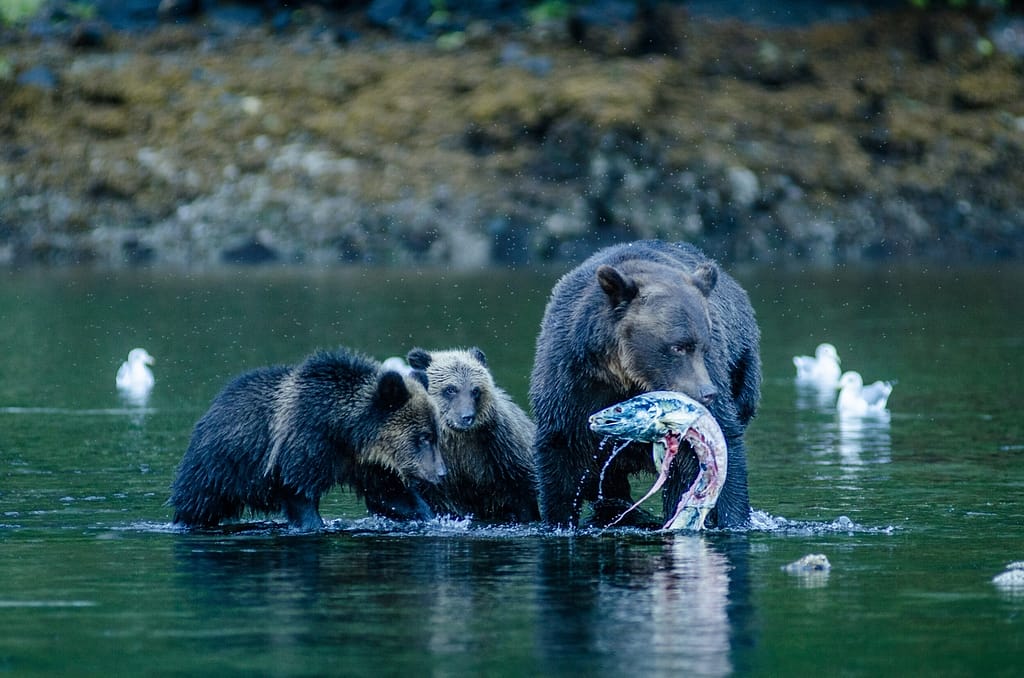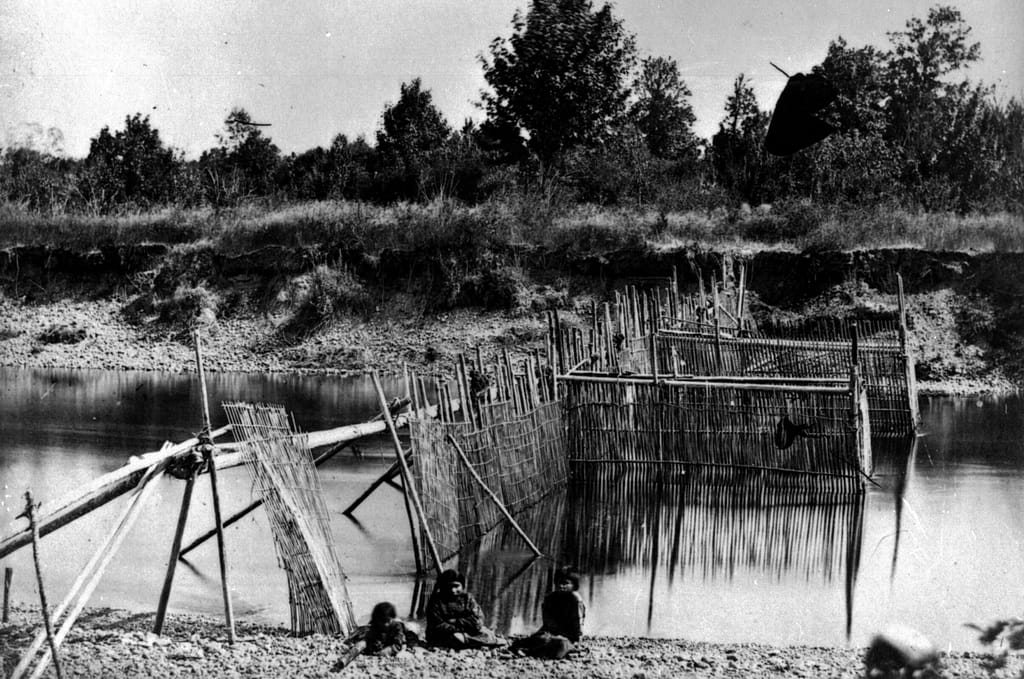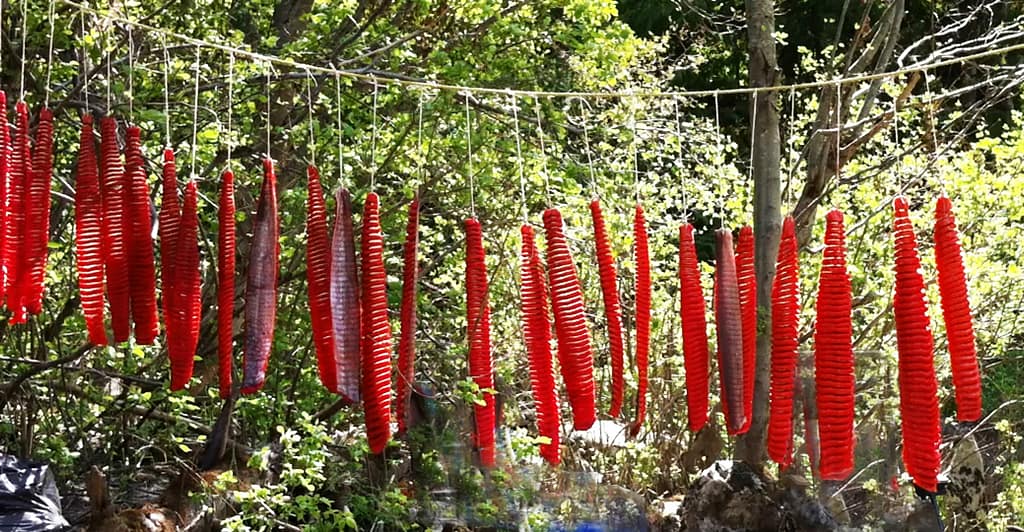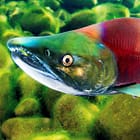 Why are wild salmon so important?
Why are wild salmon so important?
Ecology
For millennia, migrating wild salmon have nourished Pacific coast ecosystems and are vital to their diversity and abundance. In every life stage, from eggs to juveniles to adults, salmon are important food for marine, terrestrial and avian wildlife. Chinook salmon are vital food for endangered Southern Resident orca whales. Bears, eagles, wolves, and other predators catch salmon on their up-river spawning journeys and carry them into the forests to feed on.
The bodies of wild salmon represent a huge transfer of energy, nutrients and minerals from the ocean to forest ecosystems, increasing production at all levels of the food chain, from bacteria and algae communities to top predators. More than 40 species of vertebrates, including salmon, trout, birds and mammals have been found to directly benefit from annual salmon runs by feasting on salmon, their eggs, carcasses, or their young. In B.C., research revealed that among trees with major access to salmon carcasses, up to 75% of their total nitrogen appears to be derived from salmon nutrients. And trees support all that live and grow in our forests while removing carbon dioxide from the atmosphere. Salmon are essential to the health of Canada’s Pacific coastal and terrestrial ecosystems as this video demonstrates.
“The salmon is a magnificent animal that holds its own compared to anything on the Serengeti – beautiful in its many phases; thrilling in its athleticism; moving in its strength, determination, and courage; poetic in its heroic and tragic life story – and it would be sad if it were to disappear.” – Mark Kurlansky, in Salmon: A Fish, the Earth, and the History of Their Common Fate
Alexandra Morton speaks eloquently about what we can learn from the wisdom of salmon.

First Nations
Salmon are integral to First Nations’ health, culture and traditions passed down through generations over millennia. They are received by First Nations peoples as gift-bearing relatives, are treated with great respect, and feature prominently in their legends, art and ceremonies. Salmon symbolize abundance, fertility, prosperity and renewal. Prior to European contact, salmon was also an important trade item and contributor to the community economy. Salmon are still vital to First Nations’ livelihoods and culture which can bring them into conflict with the fisheries management practices of the Canadian government.
First Nations have a rich history of salmon knowledge and sustainable fishing methods. They have long-established harvesting agreements and practices for monitoring, fishing, and sharing salmon in their traditional territories. Some fishing spots were under the jurisdiction of hereditary leaders. They determined who could fish there, when they could fish, and how many they could take. Fishing spots in certain territories were family-owned and still are today such as in the Stó:lō Nation.


“Salmon are themselves a proud race. They are happy to come ashore each year and give their rich flesh to feed the people, but they must be treated with respect.” – Donna Joe, in Salmon Boy
“We consider the salmon sacred, our relatives.” – Eddie Gardner, Stó:lō Elder
Sport and Commercial Fishing
In 2016, according to the most recent statistics available, British Columbia’s fisheries and aquaculture sector contributed $1,012 million to the provincial gross domestic product (GDP) of $220 billion.
Sport and commercial fishing contributed the largest share of sector GDP ($585 million). In 1990, the salmon fishery accounted for 36% of the total commercial fishery GDP; by 2016, its share had fallen to just under 5% of the total ($195 million). Overall, GDP in the salmon fishery plunged 92% over that period. Many factors are contributing to the decline in wild salmon populations since 1990, and thus to the health of the commercial fishery. The rapid increase in Atlantic salmon farming over the same period is tough to dismiss as a factor in this decline.
By comparison, aquaculture contributed $194 million to GDP of which 92% came from salmon farming.
The fisheries and aquaculture sector employed 15,000 people in 2016: 9,000 (60%) in the sport fishing industry, 1,600 (11%) in the commercial fishery, 1,800 (12%) in aquaculture, and the rest in fish and seafood processing.
So, in terms of B.C.’s economy in 2016, sport and commercial fishing contributed three times as much as aquaculture (mostly from salmon farming) to the provincial GDP, and almost six times as much to employment.
Notably, these figures do not consider B.C.’s tourism industry which contributed $7.9 billion in GDP, and employed 133,100 people, in 2016. While wild Pacific salmon are not the only species sought by sport fishers, it is hard to imagine British Columbia as a world-class tourist destination without them. They are a keystone species in our provincial ecosystem, and thus to our “Super, Natural British Columbia” brand.


